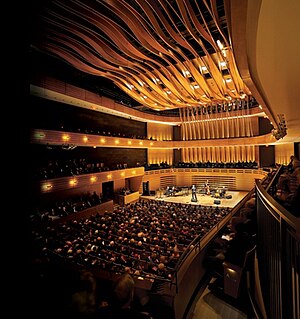Pug Awards
This article needs to be updated. (January 2023) |

The Pug Awards were a Toronto architecture award that rated buildings based on popular votes, awarded annually from 2004 to 2014. Each spring, the Pug Awards website listed all buildings completed the previous year in Toronto that either had more than 50,000 feet of floor space or were deemed noteworthy by the Pug Awards Advisory Board and Executive Committee, with voters able to “Love”, “Like” or “Hate” new developments. In 2009, buildings outside the Old City of Toronto (including North York and Etobicoke) became eligible for awards.[1] The awards were created in 2004 by Gary Berman and Anna Simone . They were originally named the "Fugly Awards" and highlighted the ugliest buildings completed, but the name was then softened to the Puglies, and finally to the Pugs, with a Pug dog as the mascot. In 2008 the awards introduced the "Pug Cup," which was carved each year with the winning building and displayed at City Hall.
2014 awards[edit]
- Best residential: River City
- Best commercial/institutional: Bridgepoint Active Healthcare
- Paul Oberman Award commercial/institutional: Bridgepoint Active Healthcare
2013 awards[edit]
- Best residential: 500 Wellington West
- Best commercial/institutional: 11 Division, Toronto Police Services
- Paul Oberman Award commercial/institutional: 11 Division, Toronto Police Services
- Worst residential: Palais at Port Royal Place
- Worst commercial/institutional: Trump International Hotel & Tower
2012 awards[edit]
- Best residential: 83 Redpath
- Best commercial/institutional: The Centre for Green Cities, Evergreen Brick Works
- Paul Oberman Award commercial/institutional: The Shops of Summerhill
- Worst residential: Pearl Condominium
- Worst commercial/institutional: Toronto Rehab University Centre, Patient Care & Research Tower
2011 awards[edit]
- Best residential: Seventy5 Portland
- Best commercial/institutional: Bell Lightbox
- Paul Oberman Award commercial/institutional: Bloor/Gladstone Library
- Paul Oberman Award residential: The Printing Factory Lofts
- Worst residential: Eleven Christie
- Worst commercial/institutional: Scarborough Gospel Temple
2010 awards[edit]
- Best residential: 60 Richmond East Housing Co-Operative
- Best commercial/institutional: Telus Centre at The Royal Conservatory of Music
- Worst residential: Grande Triomphe – Phase II
- Worst commercial/institutional: Shops at Don Mills
2009 awards[edit]
- Best residential: One Saint Thomas - Robert A.M. Stern
- Best commercial/institutional: Art Gallery of Ontario - Frank Gehry
- Worst residential: Hampton Plaza
- Worst commercial/institutional: Mount Sinai Hospital Joseph & Wolf Lebovic Centre
2008 awards[edit]
- Best residential: Argyle Authentic Lofts
- Best commercial/institutional: Hazelton Hotel
- Worst residential: 76 Shuter
- Worst commercial/institutional: Marriott Residence Inn
2007 awards[edit]
- Best residential: One King West
- Best commercial/institutional: Gardiner Museum
- Worst residential: Be Bloor Condominium
- Worst commercial/institutional: Ryerson School of Business
2006 awards[edit]
- Best residential: 18 Yorkville
- Best commercial/institutional: National Ballet School of Canada
- Worst residential: Glenlake
- Worst commercial/institutional: Cosmopolitan Hotel
2005 awards[edit]
- Best residential: Waterclub I
- Best commercial/institutional: Toronto Police Service's 51 Division
- Worst residential: Wellington Square
- Worst commercial/institutional: Queen Elizabeth Centre (Toronto Rehab)
See also[edit]
External links[edit]
References[edit]
- ^ Roberts, Rob (30 April 2009). "Architecture of the inner suburbs to get Pug Awards scrutiny this year". The National Post. Toronto. Retrieved 30 April 2009.[dead link]
- Goldberg, Brianna."Low-rise lofts triumph at annual Pug Awards."[permanent dead link] National Post. Don Mills, Ont.: Jun 5, 2008. pg. A.15
- Ouellette, Robert. "How the Pug Awards saved Toronto." National Post. Don Mills, Ont.: May 2, 2008. pg. A.10
- Hume, Christopher. "So T.O. who's the Pugliest of them all?" Toronto Star. Toronto, Ont.: Jun 7, 2006. pg. B.04
